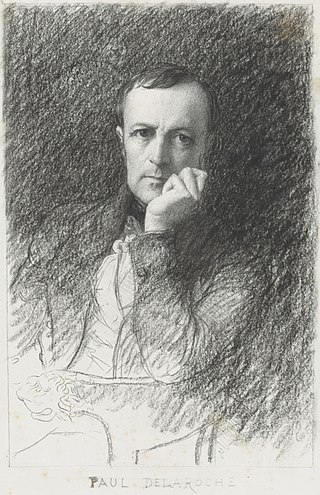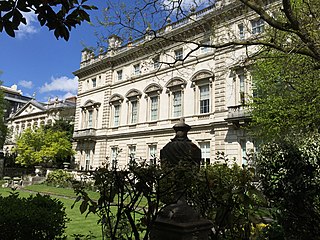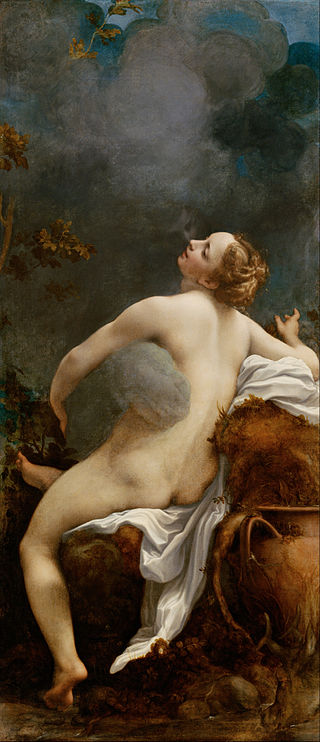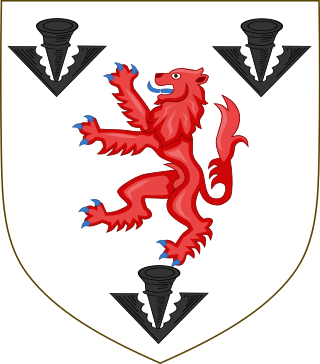
Duke of Sutherland is a title in the Peerage of the United Kingdom which was created by William IV in 1833 for George Leveson-Gower, 2nd Marquess of Stafford. A series of marriages to heiresses by members of the Leveson-Gower family made the dukes of Sutherland one of the richest landowning families in the United Kingdom. The title remained in the Leveson-Gower family until the death of the 5th Duke of Sutherland in 1963, when it passed to the 5th Earl of Ellesmere from the Egerton family.

Earl of Ellesmere, of Ellesmere in the County of Shropshire, is a title in the Peerage of the United Kingdom. It was created in 1846 for the Conservative politician Lord Francis Egerton. He was granted the subsidiary title of Viscount Brackley, of Brackley in the County of Northampton, at the same time, also in the Peerage of the United Kingdom. Born Lord Francis Leveson-Gower, he was the third son of George Leveson-Gower, 1st Duke of Sutherland and Elizabeth Gordon, 19th Countess of Sutherland. In 1803 his father had inherited the substantial estates of his maternal uncle Francis Egerton, 3rd Duke of Bridgewater. On his father's death in 1833, Lord Francis succeeded to the Egerton estates according to the will of the late Duke of Bridgewater, and assumed by Royal licence the surname of Egerton in lieu of Leveson-Gower. The Brackley and Ellesmere titles created for him in 1846 were revivals of titles held by the Dukes of Bridgewater. In 1963 his great-great-grandson, the fifth Earl, succeeded his kinsman as 6th Duke of Sutherland. The earldom of Ellesmere and viscountcy of Brackley are now subsidiary titles of the dukedom.

Earl of Bridgewater was a title that has been created twice in the Peerage of England, once for the Daubeny family (1538) and once for the Egerton family (1617). From 1720 to 1803, the Earls of Bridgewater also held the title of Duke of Bridgewater. The 3rd Duke of Bridgewater is famously known as the "Canal Duke", for his creation of a series of canals in North West England.
Francis Ronald Egerton, 7th Duke of Sutherland, known as Francis Ronald Egerton until 2000, is a British peer from the Egerton family.

Francis Egerton, 3rd Duke of Bridgewater, known as Lord Francis Egerton until 1748, was a British nobleman from the Egerton family. He was the youngest son of the 1st Duke. He did not marry, and the dukedom expired with him, although the earldom was inherited by a cousin, Lieutenant-General John Egerton.

Hippolyte-Paul Delaroche was a French painter who achieved his greater successes painting historical scenes. He became famous in Europe for his melodramatic depictions that often portrayed subjects from English and French history. The emotions emphasised in Delaroche's paintings appeal to Romanticism while the detail of his work along with the deglorified portrayal of historic figures follow the trends of Academicism and Neoclassicism. Delaroche aimed to depict his subjects and history with pragmatic realism. He did not consider popular ideals and norms in his creations, but rather painted all his subjects in the same light whether they were historical figures like Marie-Antoinette, figures of Christianity, or people of his time like Napoleon Bonaparte. Delaroche was a leading pupil of Antoine-Jean Gros and later mentored a number of notable artists such as Thomas Couture, Jean-Léon Gérôme, and Jean-François Millet.

Francis Egerton, 1st Earl of Ellesmere,, known as Lord Francis Leveson-Gower until 1833, was a British politician, writer, traveller and patron of the arts. Ellesmere Island, a major island in Nunavut, the Canadian Arctic, was named after him.

The Execution of Lady Jane Grey is an oil painting by Paul Delaroche, completed in 1833, which is now in the National Gallery in London. It was enormously popular in the decades after it was painted, but in the 20th century realist historical paintings fell from critical favour and it was kept in storage for many decades, for much of which it was thought lost. Restored and displayed again since 1975, it immediately became a highly popular work once again, especially with younger visitors.

John Sutherland Egerton, 6th Duke of Sutherland, was a British peer from the Egerton family. He was styled Viscount Brackley until 1944, when he became the 5th Earl of Ellesmere on inheriting his father's substantive title. He inherited his ducal title in 1963 from a distant cousin.

The Triumphs of Caesar are a series of nine large paintings created by the Italian Renaissance artist Andrea Mantegna between 1484 and 1492 for the Gonzaga Ducal Palace, Mantua. They depict a triumphal military parade celebrating the victory of Julius Caesar in the Gallic Wars. Acknowledged from the time of Mantegna as his greatest masterpiece, they remain the most complete pictorial representation of a Roman triumph ever attempted and together they form the world's largest metric area of Italian Renaissance paintings outside Italy.

Diana and Actaeon is a painting by the Italian Renaissance master Titian, finished in 1556–1559, and is considered amongst Titian's greatest works. It portrays the moment in which the hunter Actaeon bursts in where the goddess Diana and her nymphs are bathing. Diana is furious, and will turn Actaeon into a stag, who is then pursued and killed by his own hounds, a scene Titian later painted in his The Death of Actaeon.

Bridgewater House is a townhouse located at 14 Cleveland Row in the St James's area of London, England. It is a Grade I listed building.

Diana and Callisto is a painting completed between 1556 and 1559 by the Italian late Renaissance artist Titian. It portrays the moment in which the goddess Diana discovers that her maid Callisto has become pregnant by Jupiter. The painting was jointly purchased by the National Gallery and the Scottish National Gallery for £45 million in March 2012. Along with its companion painting Diana and Actaeon it is displayed on an alternating basis between London and Edinburgh. There is a later version by Titian and his workshop in the Kunsthistorisches Museum in Vienna.

The Orleans Collection was a very important collection of over 500 paintings formed by Philippe d'Orléans, Duke of Orléans, mostly acquired between about 1700 and his death in 1723. Apart from the great royal-become-national collections of Europe it is arguably the greatest private collection of Western art, especially Italian, ever assembled, and probably the most famous, helped by the fact that most of the collection has been accessible to the public since it was formed, whether in Paris, or subsequently in London, Edinburgh and elsewhere.

The Seven Sacraments refers to two series of paintings of the seven sacraments by the French painter Nicolas Poussin.

The Destruction of Pompeii and Herculaneum is a large 1822 painting by English artist John Martin of the eruption of Mount Vesuvius in 79 AD. It follows the pattern set by his previous successful painting, Belshazzar's Feast, which was another depiction of a dramatic scene from history delivered from an esoteric point of view. The work appeared to be lost from the Tate Gallery storerooms soon after it was damaged by the 1928 Thames flood. However, it was rediscovered in 1973 and subsequently restored in 2011.

The Egerton family is a British aristocratic family. Over time, several members of the Egerton family were made Dukes, Earls, knights, baronets and peers. Hereditary titles held by the Egerton family include the dukedoms of Bridgewater (1720–1803) and Sutherland, as well as the earldoms of Bridgewater (1617–1829), Wilton (1801–1999) and Egerton (1897–1909). Several other members of the family have also risen to prominence. The Egerton family motto is Virtuti non armis fido.

Worsley New Hall is a former mansion and gardens by the Bridgewater Canal in Worsley, Greater Manchester, England, 8 miles (13 km) west of Manchester. The gardens were renovated by the Royal Horticultural Society and opened as RHS Garden Bridgewater in 2021.

Cromwell with the Coffin of Charles I is a partially-varnished c. 1831 watercolour by Eugène Delacroix, now in the Département des Arts graphiques of the Louvre in Paris.

The Bridgewater Madonna is a religious painting by Raphael, dated 1507. Originally on oil and wood, but later transferred to canvas, it measures 81 by 55 cm. The picture is part of the permanent collection of the Scottish National Gallery in Edinburgh, on loan from the Duke of Sutherland Collection.



















